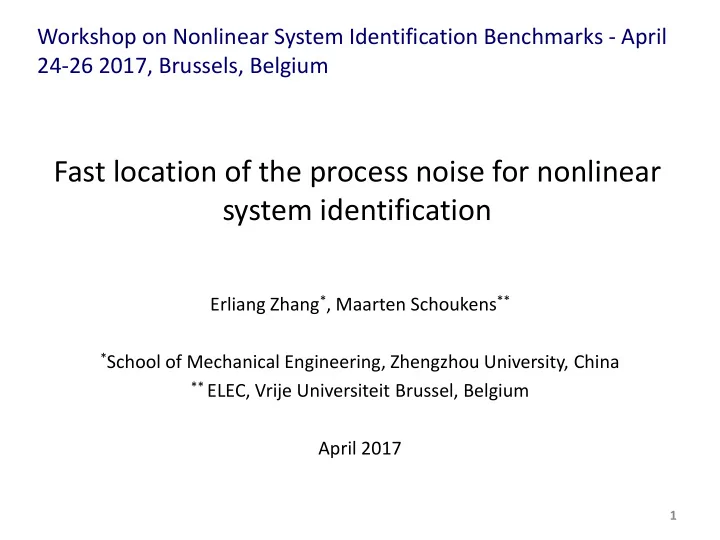

Workshop on Nonlinear System Identification Benchmarks - April 24-26 2017, Brussels, Belgium Fast location of the process noise for nonlinear system identification Erliang Zhang * , Maarten Schoukens ** * School of Mechanical Engineering, Zhengzhou University, China ** ELEC, Vrije Universiteit Brussel, Belgium April 2017 1
Content Problem statement Assumptions Previous work Basic idea & Principle Examples Conclusion 1. 2
nonlinear systems in the real world Process noise, output noise & sensor noise Wrong noise model bias BUT: Including flexible noise structure: increased computational complexity GOAL: Detect process noise in NLSS, NARMAX, Block-Oriented type of structures 3
Assumptions Measurement and process noise zero-mean stationary noises independent of input excitation Nonlinear system Periodic in, same period out Static nonlinearity approximated by polynomial n f i i f t = a x t a x t i i i 0 i 0 4
Previous work Input design: periodic but nonstationary within one period Indicator of the saturation nonlinearity Input signal through which the process noise goes in a Wiener-Hammerstein model Experiment protocol: M experiments, P periods Zhang, Erliang; Schoukens, Maarten; Schoukens, Joannes , Structure detection of Wiener- Hammerstein systems with process noise. IEEE Transactions on Instrumentation and Measurement, 66(3): 569 – 576, 2017. 5
Basic idea & principle “Specific” input narrow-band periodic signal in the pass band of the nonlinear system Connection to the previous work The amplitude of the sine signal can be seen as the expected value of the random input which is periodic but nonstationary within one period Aim Detect the model structure of nonlinear systems with process 6 noise using only one experiment
Basic idea & principle System response Case 1: 𝑦 𝑙+1 = 𝐵𝑦 𝑙 + 𝐶𝑣 𝑙 + 𝑔 𝑦 𝑙 + 𝑓 𝑙 ൞ 𝑧 𝑙 = 𝐷𝑦 𝑙 + 𝐸𝑣 𝑙 + 𝑜 𝑙 Case 2: 𝑦 𝑙+1 = 𝐵𝑦 𝑙 + 𝐶𝑣 𝑙 + 𝑔 𝑦 𝑙 ൞ 𝑧 𝑙 = 𝐷𝑦 𝑙 + 𝐸𝑣 𝑙 + 𝑜 𝑙
Basic idea & principle System response when the process noise does pass through the nonlinearity part (Case 1) 𝑦 𝑙+1 = ҧ 𝑦 𝑙+1 + 𝜀 𝑙+1 𝑧 𝑙 = 𝐷 ҧ 𝑦 𝑙 + 𝐸𝑣 𝑙 + 𝐷𝜀 𝑙 + 𝑜 𝑙 𝑜 𝑔 𝑗 𝑦 𝑙+1 = 𝐵 ҧ 𝑦 𝑙 + 𝐶𝑣 𝑙 + 𝑏 𝑗 ҧ 𝑦 𝑙 𝑗=0 𝑗! 𝑑 𝑗𝑘 = 𝑗 − 𝑘 ! 𝑘! 𝑜 𝑔 𝑗−1 𝑘 𝜀 𝑙 𝑗−𝑘 𝜀 𝑙+1 = 𝐵𝜀 𝑙 + 𝑓 𝑙 + 𝑏 𝑗 𝑑 𝑗𝑘 ҧ 𝑦 𝑙 𝑗=1 𝑘=0 δ k is function of the state variable. 8
Basic idea & principle System response when the process noise does not pass through the nonlinearity part (Case 2) 𝑦 𝑙+1 = 𝐵𝑦 𝑙 + 𝐶𝑣 𝑙 + 𝑔 𝑦 𝑙 ൞ 𝑧 𝑙 = 𝐷𝑦 𝑙 + 𝐸𝑣 𝑙 + 𝑜 𝑙 Remark that the error caused by the noise is independent of the state variable. 9
Basic idea & principle Use the periodic signal to separate the nonperiodic part (caused by the process noise and output noise) from the system nonlinearity If residual is nonstationary process noise present 10
Basic idea & principle Measurement protocol using only one experiment (proposed indicator) ˆ 2 is proposed to be rearranged accordingly with the input t of one period 11
Simulated example: NLSS 𝑦 𝑙+1 = 𝐵𝑦 𝑙 + 𝐶𝑣 𝑙 + 𝑔 𝑦 𝑙 + 𝑓 𝑙 ൞ 𝑧 𝑙 = 𝐷𝑦 𝑙 + 𝐸𝑣 𝑙 + 𝑜 𝑙 0.5 0 0 1 A 0.5 0.4 0.3 , B 0.2 , C 1 0 0 , D 0 0.3 0.8 0.6 0.3 tanh(𝑦 𝑙 (1)) 𝑔 𝑦 𝑙 = 0 0 12
Simulated example: NLSS The process noise does pass through the static nonlinearity Process Noise std: 0,01 Output Noise std: 0,01 P = 64 13
Simulated example: NLSS The process noise does NOT pass through the static nonlinearity Process Noise std: 0,00 Output Noise std: 0,01 P = 64 14
Simulated example: NARMAX 𝑦 𝑙 = 0,39𝑦 𝑙−1 − 𝑣 𝑙 + 0,1𝑦 𝑙−1 𝑣 𝑙−1 + 𝑓 𝑙 𝑧 𝑙 = 𝑦 𝑙 + 𝑜 𝑙 The process noise does pass through the static nonlinearity Process Noise std: 0,10 Output Noise std: 0,01 P = 64 15
Simulated example: NARMAX 𝑦 𝑙 = 0,39𝑦 𝑙−1 − 𝑣 𝑙 + 0,1𝑦 𝑙−1 𝑣 𝑙−1 𝑧 𝑙 = 𝑦 𝑙 + 𝑜 𝑙 The process noise does NOT pass through the static nonlinearity Process Noise std: 0,00 Output Noise std: 0,01 P = 64 16
Wiener-Hammerstein benchmark Wiener-Hammerstein benchmark P = 16, Saturation nonlinearity 17
Nonlinearity Interpretation Taylor Approximation 𝑔 𝑦 + 𝜀 ≈ 𝑔 𝑦 + 𝑔′(𝑦)𝜀 std(𝑔 𝑦 + 𝜀 ) ≈ 𝑔 ′ 𝑦 std(𝜀) 18
Conclusion Simple & Fast Applicable to a wide class of nonlinear systems Insight on the nonlinearity which the process noise goes through. 19
Recommend
More recommend